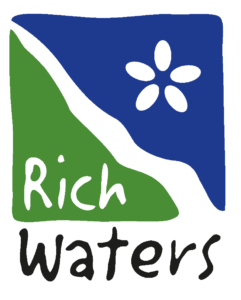Full report in Swedish (pdf)
Abstract
In this study, different types of nature-based solutions, and their multifunctional properties, have been analyzed with a focus on their flow attenuation capacity during extreme high flows. The study was commissioned by the County Administrative Boards of Västmanland and Stockholm County within the framework of the EU-funded water project Life IP Rich Waters.
The analysis covers two different types of catchment areas. One area, Duvbo, is located in the municipality of Sundbyberg and is an urban area with a high proportion of built-up areas. Duvbo drains into Bällstaån, which flows into Bällstaviken, the innermost part of Lake Ulvsunda, which is part of Lake Mälaren. The second catchment area, the Ässingån catchment area, is located in the counties of Örebro and Västmanland and is a sub-catchment of the Arbogaån river. The Ässingån catchment area is characterized by a large proportion of forest land, a significant proportion of open land and a smaller proportion of built-up land.
In Duvbo, the studied nature-based solutions have been divided into two categories: stormwater solutions and rainfall solutions. The studied stormwater solutions, for example in the form of submerged grass areas, can take up a large area but can also be used for other purposes, such as recreation. The stormwater solutions are often smaller and instead need to be more numerous in order to provide a significant flow attenuation effect during large amounts of precipitation. However, it should be added that the primary purpose of stormwater solutions is to limit flows and consequences during medium-high flows, which means that these solutions should not be rejected even if they prove to have little effect during extreme high flows. When all measures are implemented, the volume discharged to Bällstaån is reduced by about 25% from the current situation, which roughly corresponds to an event with half the return period.
In the Ässingån catchment area, possible nature-based solutions were identified through GIS analysis of elevation and land use data. The analysis included restoration of lakes, wetlands and floodplains. From this selection, the nature-based solutions with the largest storage volume and thus the largest flow attenuation capacity were selected for further analysis. The greatest flow attenuation was achieved with the solutions that had the largest storage volume and were located far downstream in the catchment area. The scenarios studied were based on historical events, with the largest event being the spring flood of 1977 with a return period for the maximum flow of about 160 years at the confluence with Arbogaån. When all nature-based solutions were implemented, the maximum flow was reduced to a flow with a return period of about 35 years at the confluence with Arbogaån.
A common conclusion for the two river basins is that large volumes are required to achieve significant flow attenuation during extreme high flows.
All implemented solutions have been rated for different types of multifunctional benefits according to an agreed scale. The rating was based on available data. In cases where the data basis has been insufficient, or the benefit is assumed to be largely dependent on the design in the planning phase, the rating has been replaced by a comment.
Since the purpose of the study is to investigate positive effects during extreme high flows, measures with large storage capacity have been prioritized. However, it should be noted that measures that contribute smaller volumes, such as ditch plugging for groundwater elevation, small wetlands, green areas in the urban environment, etc., can have a significant effect on retention during medium-high flows, contribute to biodiversity, and reduce the risk of drought.


